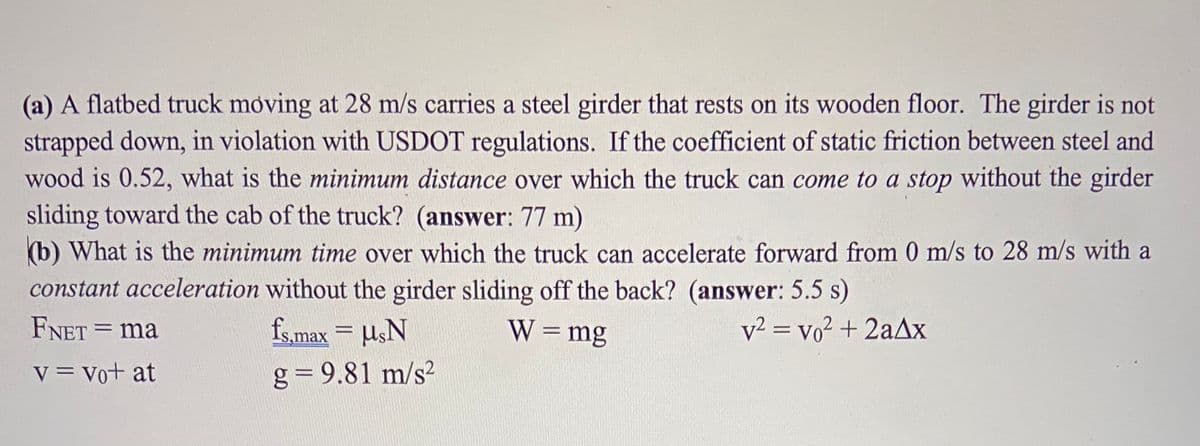(a) A flatbed truck moving at 28 m/s carries a steel girder that rests on its wooden floor. The girder is not strapped down, in violation with USDOT regulations. If the coefficient of static friction between steel and wood is 0.52, what is the minimum distance over which the truck can come to a stop without the girder sliding toward the cab of the truck? (answer: 77 m) (b) What is the minimum time over which the truck can accelerate forward from 0 m/s to 28 m/s with a constant acceleration without the girder sliding off the back? (answer: 5.5 s)
(a) A flatbed truck moving at 28 m/s carries a steel girder that rests on its wooden floor. The girder is not strapped down, in violation with USDOT regulations. If the coefficient of static friction between steel and wood is 0.52, what is the minimum distance over which the truck can come to a stop without the girder sliding toward the cab of the truck? (answer: 77 m) (b) What is the minimum time over which the truck can accelerate forward from 0 m/s to 28 m/s with a constant acceleration without the girder sliding off the back? (answer: 5.5 s)
Principles of Physics: A Calculus-Based Text
5th Edition
ISBN:9781133104261
Author:Raymond A. Serway, John W. Jewett
Publisher:Raymond A. Serway, John W. Jewett
Chapter5: More Applications Of Newton’s Laws
Section: Chapter Questions
Problem 61P
Related questions
Question

Transcribed Image Text:(a) A flatbed truck moving at 28 m/s carries a steel girder that rests on its wooden floor. The girder is not
strapped down, in violation with USDOT regulations. If the coefficient of static friction between steel and
wood is 0.52, what is the minimum distance over which the truck can come to a stop without the girder
sliding toward the cab of the truck? (answer: 77 m)
(b) What is the minimum time over which the truck can accelerate forward from 0 m/s to 28 m/s with a
constant acceleration without the girder sliding off the back? (answer: 5.5 s)
FNET = ma
fs,max = UsN
W =mg
v² = vo² + 2aAx
%3D
%3D
V = Vo+ at
g = 9.81 m/s?
Expert Solution
This question has been solved!
Explore an expertly crafted, step-by-step solution for a thorough understanding of key concepts.
This is a popular solution!
Trending now
This is a popular solution!
Step by step
Solved in 2 steps

Recommended textbooks for you

Principles of Physics: A Calculus-Based Text
Physics
ISBN:
9781133104261
Author:
Raymond A. Serway, John W. Jewett
Publisher:
Cengage Learning

Principles of Physics: A Calculus-Based Text
Physics
ISBN:
9781133104261
Author:
Raymond A. Serway, John W. Jewett
Publisher:
Cengage Learning